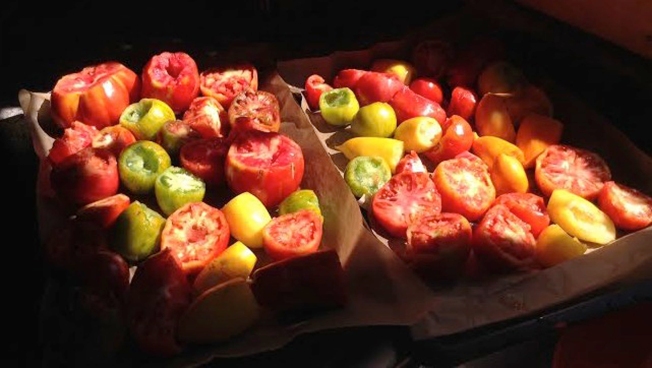By Lindsay Courcelle
It feels like almost a sin to type “winter” on the first day of autumn, but alas, that is what is on my mind. The cool morning breezes ask all of us to sleep in just a bit longer, despite lengthy fall to-do lists. Vegetable farmers are busy bringing in the harvest and watching for frosts, either protecting their crops under fabric row covers or plastic, or saying farewell to their summer vegetables.
This is also the time of year to make sure that our pantry is stocked full for the winter months, the equivalent of a squirrel gathering enough acorns. Many folks have finished their canning for the year, but we are often lagging behind with preservation. With that in mind, here are some tips from an expert procrastinator on how to ready your kitchen and pantry for the winter months.
Freeze Veggies
There are countless books and articles about canning vegetables, and many reasons to do so. Still, freezing tends to be a simpler method for us. Buying a chest freezer takes an initial investment, but if stretched over 10 years, the purchase and electrical usage equates to a cost of $3-10 per month. Don’t have space inside? We’ve successfully had our chest freezers outdoors. Some models need to be unplugged in temperatures below freezing.
We tend to take the easy route when it comes to freezing, avoiding any blanching or unnecessary steps. Some vegetables that you could freeze now without blanching are whole, cored tomatoes, great for soups, stews, or cooking down into a sauce; sweet peppers, simply cored or sliced into rings to go into stir-fries or fajitas; and hot peppers like jalapenos, to add spice to any meal. Simply place the clean, prepared veggies in a plastic freezer bag, squeeze out as much air as possible, seal, and place in the freezer. To go the extra mile, tomatoes and peppers can be roasted in the oven before freezing which will highlight their flavors in a different way. Other vegetables to freeze without blanching include shredded zucchini, to use for fritters or baking; tender broccoli; and herbs like parsley and dill.
Freeze Berries
If you are like me and missed your chance to pick berries this summer, snag some of the last fall berries and freeze them. There are still raspberries available at the Rutland Co-op and from farmers market vendors including Yoder Farm and Boardman Hill Farm. We simply put the berries into a plastic freezer bag, lay flat, and freeze.
Pick Apples
There are so many delicious apples to be had on trees in Rutland County, including right in town. Many apple trees have been abandoned and the fruit is never even picked. The apples might have small spots on them, or be misshapen, but they likely could be delicious, if not for fresh eating then for baking. The simplest way to preserve apples is to store in a cold place or to freeze them. Apples can be cored and frozen whole, sliced, or with pie spices added to the slices. Lemon juice can be added to prevent browning. Apples preserved this way are not good for fresh eating, but are great for cooking, baking, or making applesauce.
Dry Herbs
Before the heavy frosts come, pick any of the less hardy herbs that you’d like to have for winter cooking or tea. Many culinary herbs like thyme, oregano, sage and rosemary can be hung in bunches near a wood stove or in a warm, dry place and will be quickly dried. The same is true for tea herbs like peppermint and lemon balm. After the herbs are dried, place them in an airtight container and keep in a kitchen cabinet.
Store Root Cellar Crops
Home gardeners likely know that many vegetable crops can be stored through the winter if you have a root cellar or cold bedroom. Some crops, like sweet potatoes, winter squash and pumpkins prefer warm, dry conditions around 55 degrees. Garlic and onions prefer cooler, dry conditions, while root vegetables like carrots and beets need cold, moist conditions. A thermometer and humidity gauge, along with a chart of ideal storage temperatures, would come in handy for anyone who wants to store a large quantity of vegetables through the winter.
Luckily for many people, the Winter Farmers Market at the Vermont Farmers Food Center is a one-stop shopping experience for local food from November to April. But for those of us who have a bounty of vegetables that we don’t want to go to waste, these simple storage techniques may help.
Lindsay Courcelle and her husband Scott own Alchemy Gardens. Learn more at http://www.AlchemyGardensVT.com.
